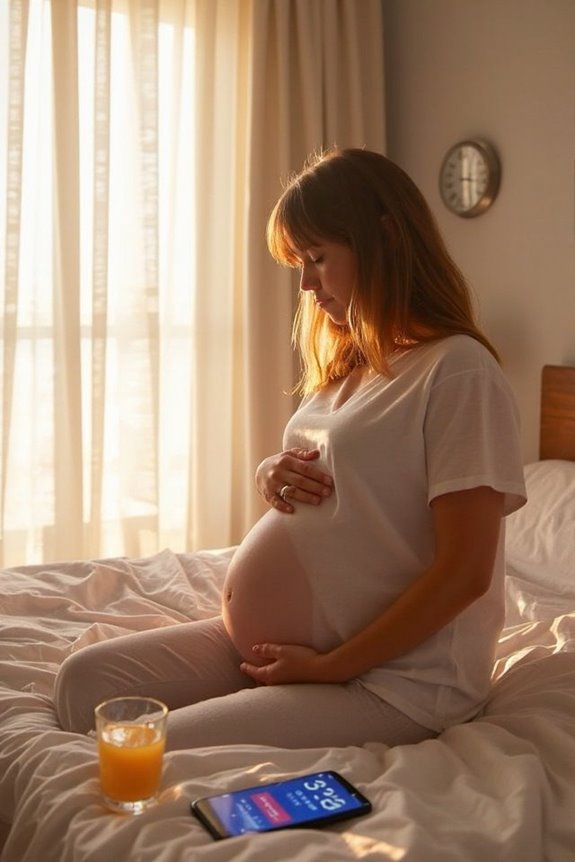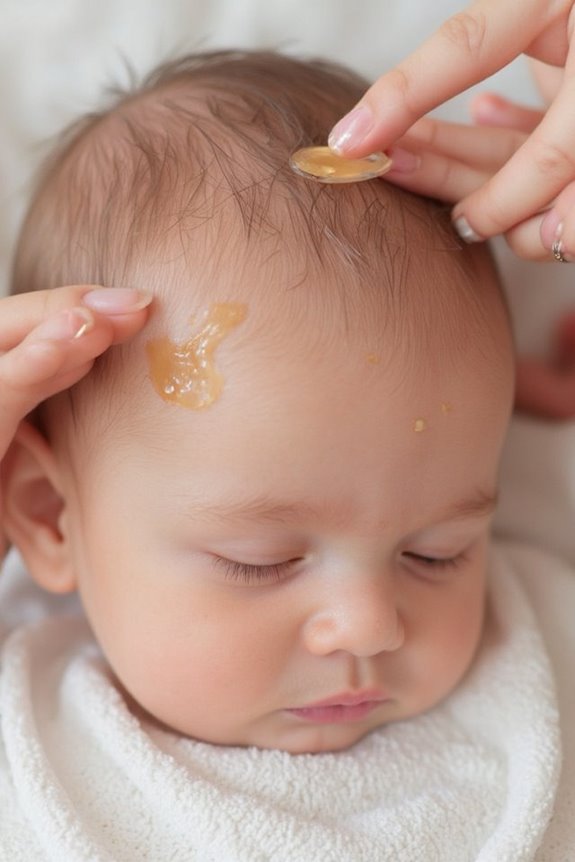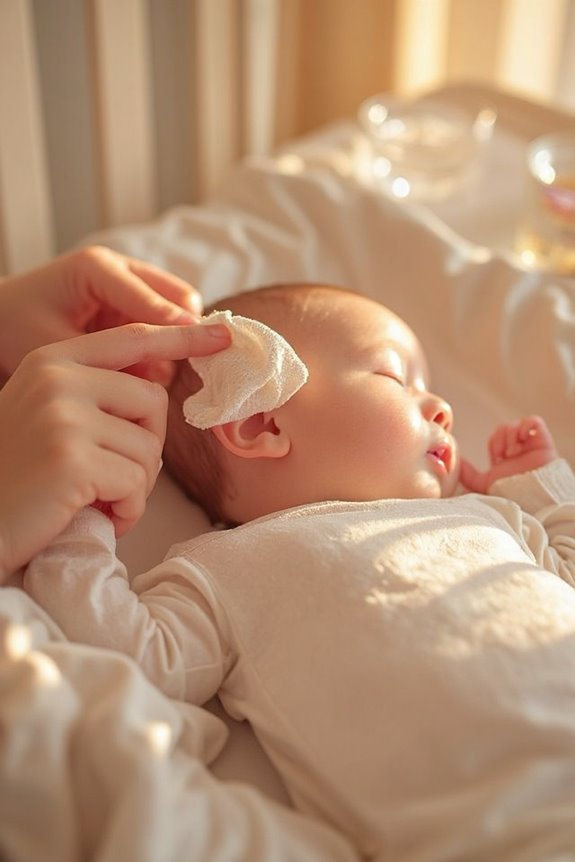Take your baby to the hospital immediately if they show severe respiratory distress: rapid breathing, chest retractions, blue lips, or difficulty feeding. For infants under 3 months, any fever above 100.4°F requires medical attention. Oxygen saturation below 90% while awake, signs of dehydration (fewer wet diapers), or extreme lethargy are emergency situations. Trust your instincts—babies with RSV can deteriorate quickly. The sections below provide critical information for protecting your little one during RSV infection.
Key Takeaways
- Seek emergency care if your baby has oxygen saturation below 90% while awake or shows bluish coloration of lips or skin.
- Take your baby to the hospital if they exhibit labored breathing with visible chest retractions or rapid, shallow breathing.
- Fever above 100.4°F warrants immediate medical attention in infants under 3 months old.
- Rush to the hospital if your baby shows signs of severe dehydration including decreased wet diapers or extreme lethargy.
- High-risk infants (premature, under three months, low birthweight) need earlier hospital intervention when showing RSV symptoms.
Respiratory Distress: Warning Signs to Act On
When your baby has RSV, recognizing the signs of respiratory distress can mean the difference between home care and emergency treatment. During respiratory assessments, watch for:
- Rapid, shallow breathing or wheezing sounds
- Nasal flaring with each breath
- Chest retractions (skin pulling inward between ribs)
- Grunting sounds during breathing
- Bluish coloration of lips or skin (cyanosis)
If you notice these symptoms, basic breathing techniques won’t help. Seek immediate medical attention if your baby:
- Struggles considerably to breathe
- Uses accessory muscles to breathe
- Has fewer than one wet diaper every eight hours
- Shows decreased alertness
- Has pale, gray, or blue-colored skin
Remember: Infants with chronic conditions or premature babies face higher risks for RSV complications and require closer monitoring.
Identifying Emergency Fever Levels in Infants

Fever thresholds for babies with RSV differ dramatically based on your infant’s age, with younger babies requiring more urgent attention. Understanding these critical temperature markers is essential for prompt medical intervention.
Age-Based Fever Guidelines:
- Under 28 days: Seek immediate medical care for any fever above 100.4°F
- Under 3 months: Report all fevers above 100.4°F to your doctor
- 3-6 months: Medical evaluation needed for fevers above 101°F
- Over 6 months: Increased concern for fevers above 102°F
When monitoring fever patterns in RSV, I recommend documenting temperature readings and symptoms. Effective temperature management includes appropriate medication under physician guidance. Watch for fevers that don’t respond to medication, especially those above 105°F, as these require emergency evaluation regardless of age.
Critical Red Flags for Immediate Medical Evaluation
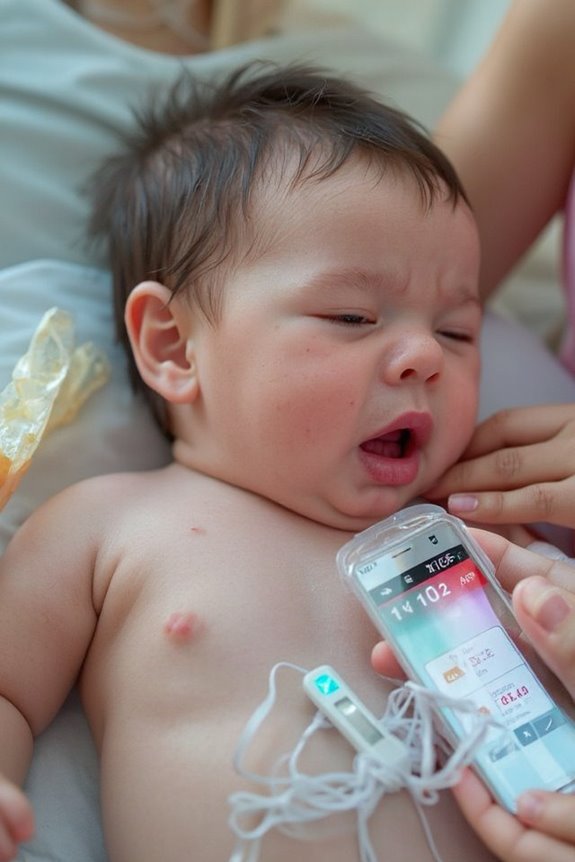
Recognizing serious warning signs in a baby with RSV can make the critical difference between home care and necessary hospitalization. As a pediatrician, I’ve seen how quickly RSV can escalate in infants, requiring urgent response to critical symptoms.
Watch for these emergency indicators:
- Labored breathing with visible chest/belly retractions
- Rapid breathing (tachypnea)
- Nasal flaring during respirations
- Blue-tinged lips or face (cyanosis)
- Dehydration signs (dry diapers, sunken eyes)
- Lethargy or difficulty waking
- Poor feeding (taking less than half normal amount)
- Apnea episodes (pauses in breathing)
These signs are particularly concerning in high-risk infants: those under 6 months, premature babies, and those with pre-existing heart or lung conditions. Don’t hesitate to seek emergency care if you observe these symptoms.
Monitoring Oxygen Saturation: When Numbers Matter
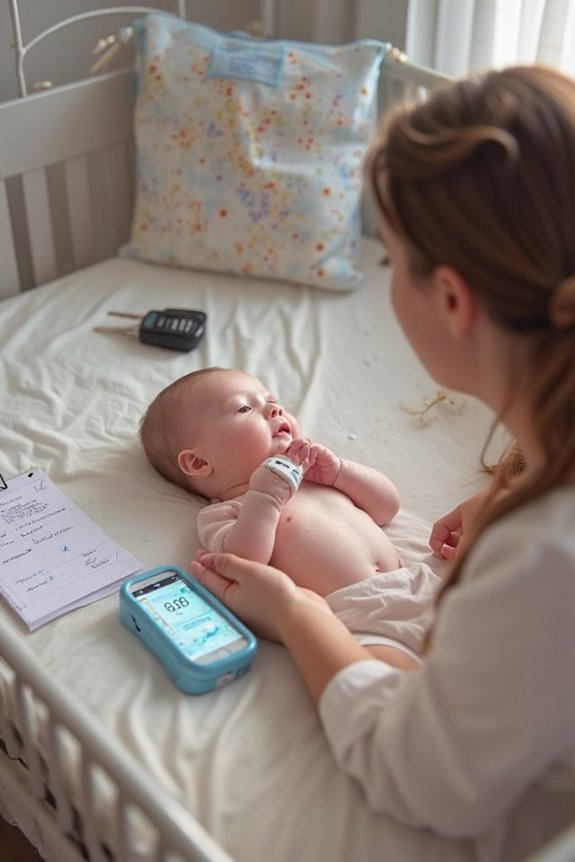
Beyond recognizing warning signs, understanding oxygen saturation levels gives you a powerful tool to evaluate your baby’s RSV severity. Doctors typically aim for specific saturation targets when treating infants with respiratory distress:
- For babies with RSV: 90-94% is generally the acceptable range
- Below 90% while awake often warrants medical attention
If your pediatrician has provided home oxygen monitoring equipment, watch for:
- Consistent readings below target ranges
- Sudden drops in oxygen levels
- Increased oxygen needs to maintain normal levels
Remember that oxygen monitoring devices have limitations. Always combine the numbers with your assessment of your baby’s overall condition—breathing effort, color, and alertness. When in doubt about concerning saturation readings, contact your healthcare provider immediately.
High-Risk Babies: Special Considerations for Hospital Care
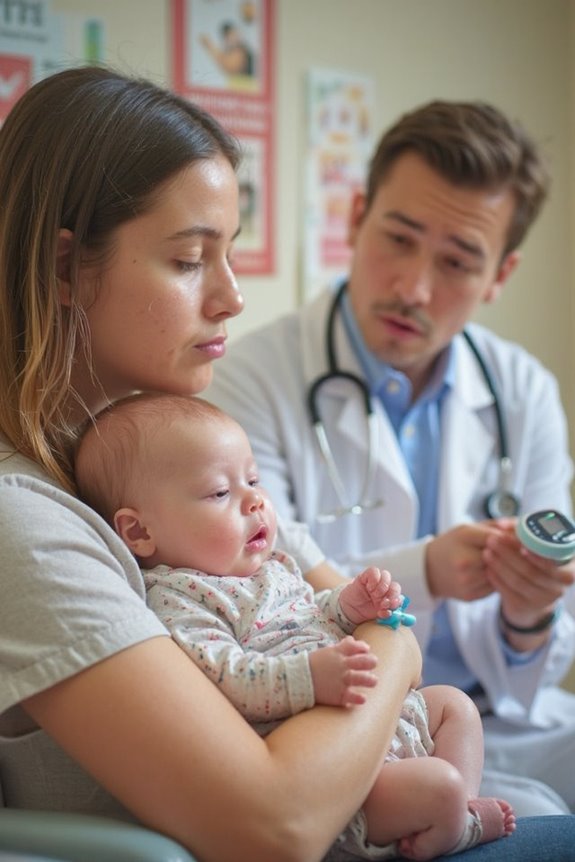
Certain infants face considerably higher dangers from RSV infections and need special attention when it comes to hospital care decisions. When evaluating high risk factors for RSV management, I pay particular attention to:
- Infants under three months old
- Premature babies (especially those born before 34 weeks)
- Low birthweight infants (under 2500g)
- Babies with heart disease or other underlying conditions
These vulnerable infants often require more aggressive monitoring and earlier hospital intervention. If your baby falls into any of these categories, don’t hesitate to seek medical care at the first signs of respiratory distress. Hospitalization rates are markedly higher for these groups, with approximately 20% of all infants having at least one risk factor for severe RSV infection. Premature infants born at or before 32 weeks may also qualify for preventive measures during RSV season.
Home Care vs. Hospital Care: Making the Decision
Deciding between home care and hospital care for an infant with RSV can be challenging for parents and healthcare providers alike. This decision requires careful risk assessment of your baby’s condition.
For home monitoring:
- Your child should be able to maintain oxygen levels above 90%
- They should be feeding adequately and staying hydrated
- You must be able to recognize worsening symptoms
Hospital care offers advantages that aren’t available at home:
- Continuous oxygen monitoring
- Immediate access to emergency interventions
- Professional care strategies for respiratory support
- Specialized equipment for breathing assistance
Family support differs in each setting. At home, you’ll need reliable help to monitor your baby around the clock. In the hospital, medical staff provides guidance while caring for your child. Always consult your pediatrician when making this important decision.
What to Expect During RSV Hospitalization
When your baby needs hospital care for RSV, you’ll enter a highly structured medical environment designed to support their recovery. Most infants stay around 5 days, though this varies based on severity.
Hospital Environment:
- Continuous monitoring of essential signs
- Strict infection control measures to prevent spread
- Medical staff evaluating your baby’s condition regularly
Treatment Options:
- Respiratory support, commonly high-flow nasal cannula (HFNC)
- Hydration management
- For severe cases, mechanical ventilation may be necessary
Your previously healthy, full-term infant can still require intensive care, as most hospitalized babies with RSV had no prior health issues. Throughout your stay, medical teams will monitor your child’s progress and prepare for discharge once their breathing stabilizes and symptoms improve.
Preventing Complications Through Early Intervention
The best defense against RSV complications starts with recognizing when your baby needs medical attention. Early detection of symptoms like labored breathing or decreased fluid intake can prevent serious outcomes, especially for infants under 6 months.
I recommend implementing these protective measures:
- Maintain supportive care at home for mild cases, ensuring adequate hydration and rest
- Monitor continuously for signs of respiratory distress
- Practice frequent handwashing and limit exposure to sick individuals
- Be extra vigilant during winter months when RSV peaks
- Know your baby’s risk factors (prematurity, heart/lung conditions)
For high-risk infants, especially premature babies, preventive medications like palivizumab may be recommended by your doctor. Remember that timely intervention greatly reduces the likelihood of long-term respiratory effects like asthma and reduced lung function.
After Hospital Discharge: Recovery and Follow-up Care
Bringing your baby home after an RSV hospitalization marks the beginning of a vital recovery period that typically lasts 1-2 weeks. During this time, your vigilance remains essential.
Follow-up appointments with your pediatrician are important to monitor your baby’s respiratory health. Focus on:
- Maintaining proper nutrition and hydration, which may require smaller, more frequent feedings
- Monitoring symptoms for any worsening or return of fever
- Preventing infection spread through hand washing and limiting visitors
Be aware that some children who experienced severe RSV may face long-term effects, including increased asthma risk. Keep vaccination updates current to prevent additional respiratory infections.
For babies with pre-existing conditions, recovery may take longer. Continue isolation practices until your doctor confirms your baby has fully recovered—typically when symptoms have been minimal for 24 hours.
Frequently Asked Questions
Can RSV Spread to Other Family Members?
While I stay vigilant about RSV transmission, you should know it absolutely can spread to family members. In fact, 32-53% of households experience transmission. Taking family precautions like handwashing is essential to protect everyone.
Does Breastfeeding Reduce RSV Severity?
Yes, I’ve seen strong evidence that breastfeeding reduces RSV severity. Breastfeeding benefits include transferring antibodies that boost your baby’s immune system, resulting in shorter hospital stays and less oxygen support when RSV occurs.
How Long Does RSV Typically Last?
I’d say RSV symptoms typically last 7-14 days, though a mild cough might linger for weeks. There’s no specific RSV treatment beyond managing symptoms, but most people recover fully within two weeks.
Can Babies Get RSV More Than Once?
Like a stubborn houseguest, RSV can visit your baby multiple times. Yes, babies can get reinfected because immunity isn’t long-lasting. Watch for RSV symptoms again and continue RSV prevention measures even after their first bout.
Are There Long-Term Effects After Recovering From RSV?
Yes, I’m concerned about long-term effects after RSV recovery. Some children may develop recurring wheezing, asthma, or reduced lung function. These respiratory issues can persist for years, especially after severe infections.


